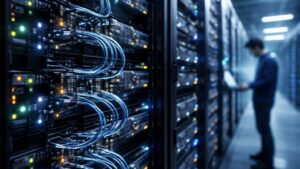The global water crisis is no longer a threat set in the future. It stands to be a reality that is knocking on the doors of industries all over the world. This rising water crisis is driving a major shift from reactive problem-solving to a proactive & intelligent approach to management. We are moving beyond simply fixing leaks when they occur. Instead, now is the time when we predict failures, optimize the use of energy, and turn water management into a strategic financial asset. This isn’t any science fiction, but the impact of advanced analytics and AI. This article goes deeper into how the new economic model works, analyzes the human-machine dynamic in the control room, and shows how the boardroom discussion around water is changing.
The New Economics of Water: Quantifying and Monetizing Predictive Insight
Our value for water is witnessing a massive change, especially at a time when the water crisis is rising. It is no longer about its price per gallon; it is more about having an idea of the full financial impact of every drop. So, this section goes through how AI water management is making new economic models:
The “Total Cost of Failure” Ledger
The majority of industries only calculate the cost of a failed pump when it breaks. It includes the repair, replacement, & downtime. However, the real total cost of failure goes much more in-depth. Imagine a crucial pump in a food processing plant that fails without any signs. Beyond the repair costs, you also go through production halts, potential spoilage of the product, and emergency labor expenses. Furthermore, this is where making use of AI predictive maintenance for industrial water systems can help you forecast failures well in advance. The system goes through:
- Vibrational data
- Temperature
- Flow rates
It flags even the more subtle anomalies. As a result, it allows for scheduled predictive maintenance, converting a high-cost emergency into a planned/low-cost repair. Additionally, it completely rewrites the financial ledger of asset management and avoids a potential localized water crisis.
The “Energy Arbitrage” Engine
Water and energy run hand in hand; moving/treating water tends to be extremely energy-intensive. An energy arbitrage engine that gets power from AI essentially changes this relation. It doesn’t just look at water treatment; it looks at the “when” part of it. For instance, an AI system can analyze energy grid pricing, which fluctuates throughout the day. It can find out if it’s cheaper to run highly intensive purification processes, let’s say, overnight when the electricity is less expensive, filling storage tanks for use during the peak hours. Additionally, this smart way of scheduling is a crucial element of AI water management. It makes way for a facility to buy low and use high, giving incredible cost savings. It is also a practical method for reducing operational risk in water management with AI in Europe, where energy costs are of great concern.
The “Compliance-at-Risk” Score
Meeting environmental regulations is non-negotiable, but it is usually a reactive process. The Compliance-At-Risk score flips this script. This AI tool consistently goes through effluent data, chemical dosages, and performance of the equipment against regulatory limits. Moreover, the tool gives a forward-looking risk score, contrary to an alarm sounding when the violation takes place. It might say, “There is a 70% probability of exceeding the discharge limits within the next 48 hours due to degradation of the filters.” This insight allows operators to correct before the breach takes place. As a result, it avoids hefty fines, damage to the reputation, & also legal trouble. It stands to be a strong tool for going through the complex space of EU water regulations in the times of a growing water crisis.
Human Capital Optimization
The usual image of a plant operator is someone who is going around with a clipboard, manually checking each gauge. This stands to be an incredibly inefficient use of skilled human capital, especially at a time when the water crisis pushes you to double-check each decision. AI systems automate the repetitive monitoring tasks, freeing up experienced operators to put their minds to higher-value activities. They can focus on:
- Analyzing trends that AI spots,
- Strategizing long-term efficiency improvements,
- And training the next generation
Mind you, this shift does not replace humans; it elevates them. It makes their role go from manual monitors to strategic overseers. As a result, it ensures that their expertise is applied where it matters the most, a major benefit of AI predictive maintenance for industrial water systems.
The Cognitive Control Room: Reshaping the Human-Machine Workflow
Today’s control rooms are less about screens with static numbers and more about dynamic/ collaborative intelligence. It is witnessing evolution into a cognitive hub where human expertise & ML work together to make smarter decisions. So, this section goes through the next workflow and how it reshapes operational reality, tackling the water crisis on the front lines:
The “Probabilistic” Work Order
Standard work orders tend to be binary: a part has either faced failure or it hasn’t. A probabilistic work order, made by an AI, shows far more nuance and power. It finds its basis in the probability of failure. For instance, instead of saying “Repair Pump X”, it might convey “Pump X has an 85% probability of failure in the next 25 days, with the most likely cause being bearing water. Action suggested: Schedule predictive maintenance within the next two weeks.” Additionally, this makes way for maintenance teams to make tasks based on actual risk a priority rather than routine schedules. They can bundle repairs in the same area, order parts in advance, and also prevent cascading failures. This makes operations far more resilient/efficient.
The “What-If” Simulation Engine
One of the most powerful tools in AI water management stands to be its ability to see the future or its plausible versions. A “what-if” simulation engine allows operators to game out several scenarios without any risks in the real world. An operator that is facing a sudden shortage of chemical supply can ask the AI, “What is the operational impact of running at 45% chemical dosage for 12 hours?” The system can simulate the effects it will have on:
- Water quality
- Equipment stress
- And compliance
This makes it a data-backed recommendation. Additionally, it empowers operators to make informed decisions even under pressure. This stands to be a critical ability for reducing operational risk in water management with AI in Europe, where supply chain disruptions can be a major factor.
The Autonomous “System Calming” Protocol
Industrial water systems are extremely complex & prone to shocks such as a sudden influx of wastewater. This throws everything off balance. Furthermore, an autonomous system calming protocol acts as a digital shock absorber. When the AI spots a critical disruption, it steps in with small adjustments across the system to soften the impact. It might trim flow rates in one spot, boost aeration in another, or tweak chemical dosing where needed. These quick, coordinated moves keep the system from tipping into a full-scale emergency. It also keeps operational stable & avoids costly shutdowns. This stands to be crucial at the time of a water crisis.
The Generative R&D Partner
Today, you can optimize beyond the processes you already have. This is about making use of AI to invent entirely new ones. Think of generative AI, similar to those that craft text/art, but focused on chemical or physical processes. An operator can present it with a novel challenge, such as “ we have a new contaminant in the influent, and we need to achieve almost 99.8% removal without incurring any capital expenditure.” This AI would not just tweak the settings; it would create several entirely new paths to achieve the goal. Moreover, it can also suggest a novel sequence of valve operations or a different method to cycle existing filters that no humans might have thought about. So, this changes the operator from a system monitor to a real-time R&D professional, co-making hyper-efficient solutions with AI as the creative assistant.
The Boardroom Recalibration: Water as a Strategic Financial Asset
At the time of a global water crisis, a genuinely strategic approach goes beyond playing defense. Preventing failures & cutting costs are crucial, but so is creating wins. The boardroom recalibration takes place when the focus shifts to generating new forms of value rather than just mitigating operational risks. So, this section goes through the offensive playbook of turning water intelligence into a very competitive weapon:
The “Verifiable ESG” Bond
Investors/financial institutions are demanding verifiable proof of sustainability claims. An AI water management system gives just that. It creates immutable/real-time data on:
- Water usage
- Recycling rates
- Discharge Quality
Furthermore, this data can be put to use to back up the issuance of verifiable ESG bonds, where the company commits to particular water-saving targets. Moreover, achieving these targets, proven by AI’s data, can result in lower interest rates for the bond. So, this makes a direct financial incentive for sustainable water practices. It is also a great example of AI-driven asset valuation for water infrastructure ESG reporting, turning good stewardship into a tangible instrument of finance.
The AI-Driven Water Purity Index
Water purity is not one of those pass/fail metrics. An AI water purity index gives a more sophisticated and consistent score. It goes through dozens of parameters in real-time. This makes a composite score that reflects the overall health/quality of the water. Furthermore, this index can come in use internally to benchmark performance or externally as a transparent metric for corporate sustainability reports. Let’s say for a beverage company, this high purity index becomes a marketable asset or a symbol of quality/ safety. This transforms a technical measurement into a powerful brand/valuation tool. This is critical for strong AI-driven asset valuation for water infrastructure ESG reporting.
AI-Powered Resource Harvesting from Wastewater
The water crisis is intensifying, and there needs to be innovation on your side. This strategy reframes wastewater from a costly liability to a revenue-generating asset. This is where AI water management goes from optimization to direct creation of value. Moreover, advanced sensors feed a real-time chemical profile of the effluent of the AI, which controls the extraction methods. Furthermore, the system tweaks settings like membrane pressure and pH to pull out what it needs. For instance, it can isolate phosphorus to turn it into fertilizer or recover metals like copper that can be sold again. When it comes to the boardroom, this is a major shift that:
- Creates strong revenue,
- Improves supply chain resilience by insourcing materials,
- And cuts waste disposal & chemical treatment costs
Water-as-a-Service (WaaS) Intelligence Layer
The future of industrial water may not be about owning equipment but buying outcomes. The Water-as-a-Service (WaaS) model is where a third-party provider manages the water treatment of a company. It is a growing concept. An AI intelligence layer is the secret sauce when it comes to making the model extremely effective. It gives the data and predictive maintenance abilities that allow the provider to make sure of great performance, uptime & water quality at a fixed cost. Additionally, this provides the industrial client with predictable expenses and also frees them from the headache of operations. Also, it gives way for them to focus on the core business while making sure their water requirements are met in the most efficient manner. This stands to be vital during a time of water crisis.
To Sum Up
The growing water crisis is pushing a necessary/powerful innovation. We are witnessing a very value-driven approach with the use of AI water management & predictive maintenance. Industries are able to quantify the true cost of failure and find the hidden inefficiencies in the use of energy. They are also able to turn compliance into a strategic advantage rather than a burden, amongst many other things. Moreover, the tools & strategies in the article are pushing industrial water management in new directions.
If you’d like a closer look and a chance to meet the people driving these changes, the 2nd Industrial Water & Wastewater Management Summit is just the place to be. It takes place in Barcelona on October 7–8. Register now!




